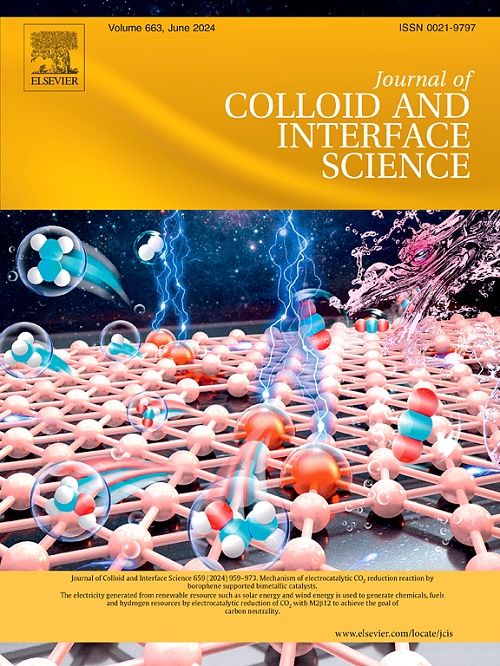利用cufe2o4活化的十面体BiVO4设计z型异质结,以调节过氧单硫酸盐活化诺氟沙星降解自由基的生成途径
IF 9.4
1区 化学
Q1 CHEMISTRY, PHYSICAL
引用次数: 0
摘要
构建异质结来激活过氧单硫酸盐(PMS)解决了单个材料中光生电荷分离不良的挑战,但带对准对复合材料中活性氧(ROS)生成的影响经常被忽视。在这项研究中,成功地开发了一种新的z方案体系,通过水热和煅烧方法将铁酸铜(CuFe2O4)与钒酸铋(BiVO4)结合,用于PMS活化。值得注意的是,水通过BiVO4的价带空穴氧化和CuFe2O4的导带电子还原氧(O2)分别显著促进了羟基自由基(HO•)和超氧自由基(O2−•)的产生。此外,通过双金属氧化还原循环产生的额外活性位点,加上CFO/BVO表面上氧空位的形成,增强了通过PMS活化的非自由基途径。CuFe2O4@BiVO4/Vis/PMS体系在30 min内对诺氟沙星(NOR)的降解效率达到96.15%,分别是CuFe2O4和BiVO4催化剂的6.39倍和1.38倍。在CuFe2O4@BiVO4/Vis/PMS体系中,与BiVO4/Vis/PMS体系相比,HO•含量增加了2.20倍,O2−•含量增加了1.49倍,单重态氧(1O2)产量增加了至少3.55倍。该系统具有优异的稳定性、可回收性和广泛的污染物降解能力,为PMS活化和靶向ROS生成提供了一种新的策略,同时推进了用于废水处理的可见光驱动可重复使用光催化剂的设计。本文章由计算机程序翻译,如有差异,请以英文原文为准。

Engineering Z-scheme heterojunction via CuFe2O4-activated decahedral BiVO4 for tuned radical generation pathways in peroxymonosulfate activation for norfloxacin degradation
Constructing heterojunctions to activate peroxymonosulfate (PMS) addresses the challenge of poor photogenerated charge separation in individual materials, yet the effect of band alignment on reactive oxygen species (ROS) generation in composites is often overlooked. In this study, a novel Z-scheme system is successfully developed for PMS activation by integrating copper ferrite (CuFe2O4) with bismuth vanadate (BiVO4) through hydrothermal and calcination methods. Notably, the production of hydroxyl radicals (HO•) and superoxide radicals (O2−•) is significantly boosted by water oxidation via valence band holes of BiVO4 and oxygen (O2) reduction by conduction band electrons of CuFe2O4, respectively. Moreover, the non-radical pathways via PMS activation are enhanced by the additional active sites generated through bimetallic redox cycling of ≡Cu+/≡Cu2+ and ≡Fe2+/≡Fe3+, coupled with the formation of oxygen vacancies on the CFO/BVO surface. The CuFe2O4@BiVO4/Vis/PMS system achieves 96.15 % norfloxacin (NOR) degradation efficiency within 30 min, significantly outperforming the individual CuFe2O4 and BiVO4 catalysts by 6.39 and 1.38 times, respectively. In the CuFe2O4@BiVO4/Vis/PMS system, the HO• content increases by 2.20 times, the O2−• level by 1.49 times, and singlet oxygen (1O2) production by at least 3.55 times compared to the BiVO4/Vis/PMS system. This system demonstrates excellent stability, recyclability, and broad pollutant degradation capability, offering a novel strategy for PMS activation and targeted ROS generation while advancing the design of visible-light-driven reusable photocatalysts for wastewater treatment.
求助全文
通过发布文献求助,成功后即可免费获取论文全文。
去求助
来源期刊
CiteScore
16.10
自引率
7.10%
发文量
2568
审稿时长
2 months
期刊介绍:
The Journal of Colloid and Interface Science publishes original research findings on the fundamental principles of colloid and interface science, as well as innovative applications in various fields. The criteria for publication include impact, quality, novelty, and originality.
Emphasis:
The journal emphasizes fundamental scientific innovation within the following categories:
A.Colloidal Materials and Nanomaterials
B.Soft Colloidal and Self-Assembly Systems
C.Adsorption, Catalysis, and Electrochemistry
D.Interfacial Processes, Capillarity, and Wetting
E.Biomaterials and Nanomedicine
F.Energy Conversion and Storage, and Environmental Technologies

 求助内容:
求助内容: 应助结果提醒方式:
应助结果提醒方式:


